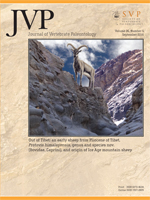As in modern elasmobranchs (sharks and rays), the shagreen of the hybodontiform shark Tribodus limae (Santana Formation, Aptian-Albian, Lower Cretaceous, northeastern Brazil) consists of non-growing (monodontode) dermal denticles that were shed, replaced, and supplemented by new ones during life. In modern elasmobranchs, these denticles are usually represented by a single size class (considered here to be the default arrangement), although larger denticles are sometimes present locally (e.g., thorn rows on the head and trunk in batomorphs). In Tribodus, however, the shagreen consists of two distinct morphological denticle types and size classes (two-size), both widely distributed over the body and fins, with smaller denticles overlying the bases of larger thorns as well as occupying areas between them. Using two conceptually distinct variants of a two-layer reaction-diffusion (R-D) simulation that is consistent with morphogen exchange across the basal lamina between the epidermal and dermal layers, we recovered two-size spatial arrangements similar to the Tribodus shagreen. Our results suggest that denticle patterning in the dermal skeleton of sharks can be replicated using R-D models with kinetics similar to those previously applied to a known mechanism of feather bud patterning in birds and to skin pigmentation patterning in modern teleost fishes. Reaction-diffusion simulations operationalize Reif's ‘odontode regulation theory,’ and so have an important conceptual place in the history of research on the dermal skeleton. Such a modeling framework may enable conceptual links to be drawn among seemingly disparate denticle arrays in Paleozoic and recent chondrichthyans, thereby guiding future work on the molecular and histological underpinnings of dermal skeleton development and evolution.
How to translate text using browser tools
1 September 2016
Dermal Denticle Patterning in the Cretaceous Hybodont Shark Tribodus limae (Euselachii, Hybodontiformes), and Its Implications for the Evolution of Patterning in the Chondrichthyan Dermal Skeleton
John G. Maisey,
John S. S. Denton





